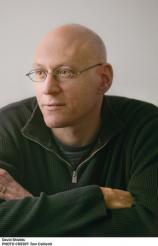Salinger
Review
Salinger
Early every morning Salinger went to that bunker with his lunch and wrote until late in the evening, giving strict orders that he was not to be disturbed for anything unless the house was burning down.
--- John C. Unrue
This is one of hundreds of vignettes in an unusual combination of personal and documentary “evidence” in the case of J. D. (Jerry) Salinger vs. The World, laboriously compiled by author David Shields and director/producer/writer Shane Salerno (who has produced a documentary film also titled Salinger).
Salinger, highly acclaimed in the 1950s and ’60s as the author of the classic antiestablishment novel THE CATCHER IN THE RYE, surprised his fans and fellow writers by spending the last 40-plus years of his life in nearly total seclusion.
"Though SALINGER shines a strong spotlight on a driven, complex and creative man, his true motivations remain, despite this comprehensive investigation, hidden in the shadows."
Over the course of nine years, Shields and Salerno attempted to track down the truth (and, some would say, track in the dirt) about this odd duck, who passed away in 2010, leaving, it has been established, several book-length works ready for publication. Presumably that was the legacy he offered his two children, who had scant fatherly attention growing up. Those close to the mysterious figure swore that he cared at least as much about his fictional Glass family and hero Holden Caulfield, who imbued the word “phoney” with near-sacred significance for a generation of disillusioned young people, as he did about his real friends and family. Having achieved more than most writers dare hope for by his early 30s, Salinger never quite matched his own high-water mark again, though his secondary books have their moments. So embedded was the Caulfield ethos in American subculture that one murderer “credited” him with providing the impetus for the assassination of Beatle John Lennon.
The names of the book’s contributors (some quoted posthumously, others having advised or assisted with the creation of this gargantuan work) form an impressive study in contrasting viewpoints. Norman Mailer termed Salinger’s later novellas “the most slovenly portion of prose ever put out by an important American writer.” Jean Miller, an early flame, avowed, “I never felt that he in any way needed me.” Gore Vidal griped, “How can someone write eighteen hours a day and then not publish for forty years?” Lillian Ross recalled, “No one else could make me laugh --- genuinely laugh aloud --- as he could.” Even the great man himself: “I think writing is a hard life…the compensations are few, but when they come, if they come, they’re very beautiful.”
Shields and Salerno identify 10 conditions that made Salinger the man and the artist he was, among them Anatomy (born with only one testicle, Salinger sought young women who would not be experienced enough to judge him); War (the landing at Utah Beach and later visit to a concentration camp left Salinger enraged and depressed); Vedanta (his chosen spiritual path, a renunciation of the world); Girls (the many barely post-adolescent females whom he courted, deflowered and dumped); and Seclusion (his “Do Not Disturb” sign to the world that longed to communicate with him).
Though SALINGER shines a strong spotlight on a driven, complex and creative man, his true motivations remain, despite this comprehensive investigation, hidden in the shadows. But if reading about J. D. Salinger impels you to read THE CATCHER IN THE RYE for the first, second or even third time, the authors have not labored in vain.
Reviewed by Barbara Bamberger Scott on September 20, 2013
Salinger
- Publication Date: September 3, 2013
- Genres: Biography, Nonfiction
- Hardcover: 720 pages
- Publisher: Simon & Schuster
- ISBN-10: 1476744831
- ISBN-13: 9781476744834











